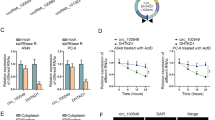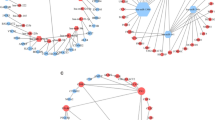Abstract
Purpose
To investigate the role of miR-585 in the development and progression of non-small-cell lung cancer (NSCLC).
Methods
The expression levels of miR-585 in NSCLC cell lines and clinical samples were measured by quantitative PCR. NSCLC cells, A549 and H1299, were stably transfected with lentiviral vectors of miR-585 mimics or negative control. The effects of miR-585 on cell proliferation were detected both in vitro and in vivo. Cell migration and invasion were evaluated using wound healing assay and Transwell assay. Furthermore, luciferase reporter assay was used to identify the direct regulation of hSMG-1 by miR-585.
Results
Our results showed that miR-585 was downregulated in NSCLC cell lines and tumor tissues. Ectopic expression of miR-585 inhibited the ability of cell proliferation, migration, and invasion in vitro. In addition, miR-585 also decreased the growth rate of xenografted tumor in nude mice. Mechanically, miR-585 directly targeted the 3′-untranslated region (UTR) of hSMG-1 gene, which likely resulted in a dysfunction of mRNA surveillance and nonsense-mediated mRNA decay.
Conclusion
Taken together, miR-585 probably has an inhibitory effect on tumor growth and is a prognostic biomarker of NSCLC.




Similar content being viewed by others
References
Siegel RL, Miller KD, Jemal A. Cancer statistics, 2015. CA Cancer J Clin. 2015;65(1):5–29.
Bartel DP. MicroRNAs: genomics, biogenesis, mechanism, and function. Cell. 2004;116(2):281–97.
Bartel DP. MicroRNAs: target recognition and regulatory functions. Cell. 2009;136(2):215–33.
Del Vescovo V, Grasso M, Barbareschi M, Denti MA. MicroRNAs as lung cancer biomarkers. World J Clin Oncol. 2014;5(4):604–20.
Yu SL, Chen HY, Chang GC, Chen CY, Chen HW, Singh S, et al. MicroRNA signature predicts survival and relapse in lung cancer. Cancer Cell. 2008;13(1):48–57.
Raponi M, Dossey L, Jatkoe T, Wu X, Chen G, Fan H, et al. MicroRNA classifiers for predicting prognosis of squamous cell lung cancer. Cancer Res. 2009;69(14):5776–83.
Uesugi A, Kozaki K, Tsuruta T, Furuta M, Morita K, Imoto I, et al. The tumor suppressive microRNA miR-218 targets the mTOR component Rictor and inhibits AKT phosphorylation in oral cancer. Cancer Res. 2011;71(17):5765–78.
Patnaik SK, Kannisto E, Knudsen S, Yendamuri S. Evaluation of microRNA expression profiles that may predict recurrence of localized stage I non-small cell lung cancer after surgical resection. Cancer Res. 2010;70(1):36–45.
Sun Y, Chen C, Zhang P, Xie H, Hou L, Hui Z, et al. Reduced miR-3127-5p expression promotes NSCLC proliferation/invasion and contributes to dasatinib sensitivity via the c-Abl/Ras/ERK pathway. Sci Rep. 2014;4:6527.
Wu X, Piper-Hunter MG, Crawford M, Nuovo GJ, Marsh CB, Otterson GA, et al. MicroRNAs in the pathogenesis of Lung Cancer. J Thorac Oncol. 2009;4(8):1028–34.
Ventura A, Jacks T. MicroRNAs and cancer: short RNAs go a long way. Cell. 2009;136(4):586–91.
Yamashita A, Ohnishi T, Kashima I, Taya Y, Ohno S. Human SMG-1, a novel phosphatidylinositol 3-kinase-related protein kinase, associates with components of the mRNA surveillance complexand is involved in the regulation of nonsense-mediated mRNA decay. Genes Dev. 2001;15(17):2215–28.
McIlwain DR, Pan Q, Reilly PT, Elia AJ, McCracken S, Wakeham AC, et al. Smg1 is required for embryogenesis and regulates diverse genes via alternative splicing coupled to nonsense-mediated mRNA decay. Proc Natl Acad Sci USA. 2010;107(27):12186–91.
Denning G, Jamieson L, Maquat LE, Thompson EA, Fields AP. Cloning of a novel phosphatidylinositol kinase-related kinase: characterization of the human SMG-1 RNA surveillance protein. J Biol Chem. 2001;276(25):22709–14.
Robert T. Abraham. The ATM-related kinase, hSMG-1, bridges genome and RNA surveillance pathways. DNA Repair. 2004;3(8–9):919–25.
Oliveira V, Romanow WJ, Geisen C, Otterness DM, Mercurio F, Wang HG, et al. A protective role for the human SMG-1 kinase against tumor necrosis factor-alpha-induced apoptosis. J Biol Chem. 2008;283(19):13174–84.
Brumbaugh KM, Otterness DM, Geisen C, Oliveira V, Brognard J, Li X, et al. The mRNA surveillance protein hSMG-1 functions in genotoxic stress response pathways in mammalian cells. Mol Cell. 2004;14(5):585–98.
Shiloh Y. ATM and related protein kinases: safeguarding genome integrity. Nat Rev Cancer. 2003;3(3):155–68.
Gubanova E, Brown B, Ivanov SV, Helleday T, Mills GB, Yarbrough WG, et al. Downregulation of hSMG-1 in HPV-positive head and neck squamous cell carcinoma due to promoter hypermethylation correlates with improved survival. Clin Cancer Res. 2012;18(5):1257–67.
Acknowledgments
Research grants from the Shanghai Municipal Health Bureau (No. 201540139), and Shanghai Jiao Tong University Medical-Engineering Interdisciplinary Research Foundation (No. YG2015MS71).
Author information
Authors and Affiliations
Corresponding authors
Ethics declarations
Conflict of interest
The authors indicate no potential conflicts of interest.
Ethical approval
All procedures performed in this study involving human participants were in accordance with the ethical standards of the Declaration of Helsinki and its later amendments. The animal study was conducted in accordance with the Institutional Animal Care and Use Committee (IACUC) guidelines and was approved by Tongji University Animal Center.
Informed consent
Informed consent was obtained from all individual participants included in the study.
Additional information
X. Ding and Y. Yang contributed equally to this work.
Rights and permissions
About this article
Cite this article
Ding, X., Yang, Y., Sun, Y. et al. MicroRNA-585 acts as a tumor suppressor in non-small-cell lung cancer by targeting hSMG-1 . Clin Transl Oncol 19, 546–552 (2017). https://doi.org/10.1007/s12094-016-1562-5
Received:
Accepted:
Published:
Issue Date:
DOI: https://doi.org/10.1007/s12094-016-1562-5




